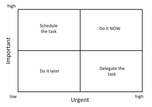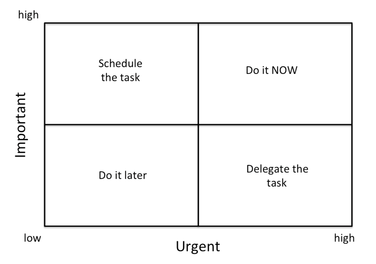 A well-known model for decision-making is the Eisenhower Matrix. It is not only a tool for prioritizing tasks, but for determining the correct action you should take to complete the task. Even if you are already familiar with the matrix, there are things you may want to consider that can help improve how the model is used.  The Eisenhower Matrix was arguably popularized by Stephen Covey and reportedly used by President Dwight D. Eisenhower. Seemingly straightforward, a person uses the matrix by creating an initial ‘to do list’ of every task they must complete and then goes back through and ranks each task as either being high or low on two critical factors; (1) the importance of the task and (2) urgency of the task. The end result is each task ends up in one of four quadrants, high/high, low/low, high/low, low/high (see diagram to the right). Tasks determined to be high on both criteria, urgent and important, are tasks to be addressed immediately. Then there are tasks that are urgent, but not important. Those tasks need to be delegated as soon as possible. For tasks that are not urgent, you schedule them if they are of high importance and let those of low importance just sit on the list. After the initial list is created, tasks are accomplished and new tasks surface, a person must mentally estimate in which quadrant the new task should reside. Tasks that are urgent should be taken care of immediately, either by doing the task or delegating to someone else. All other tasks should be written down on your ‘to do list’. Applying the Matrix While the concept of the Eisenhower matrix can be useful, there are some practical considerations when going from concept to application. Here are few things to consider if you plan on using the matrix;
For many people the Eisenhower Matrix has been found to be a helpful tool, supporting decision-making, problem-solving and critical thinking skills. This does not mean the tool is right for everyone. For instance, if you don’t have anyone to which you might delegate urgent, but non-important tasks, then one quadrant of the matrix is unavailable to you. In the end, like most decision-making tools, you may have to work with it for a while to determine to what extent it meets your needs.
0 Comments
Your comment will be posted after it is approved.
Leave a Reply. |
Authors
Richard Feenstra is an educational psychologist, with a focus on judgment and decision making.
(read more) 
Bobby Hoffman is the author of "Hack Your Motivation" and a professor of educational psychology at the University of Central Florida.
(read more) Archives
April 2023
Categories |
 RSS Feed
RSS Feed
